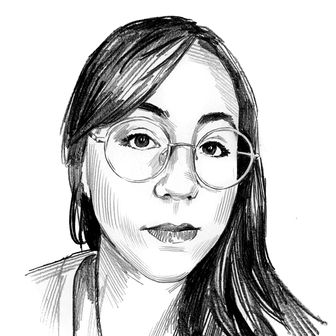
This review originally ran on January 21, 2024. We’ve republished it with I Saw the TV Glow now streaming on Max.
The characters in I Saw the TV Glow are obsessed with a show called The Pink Opaque that’s about two teenagers with glowing ghost tattoos on their necks who met at summer camp and fight supernatural evil using their connection on the psychic plane. It’s reminiscent of the revival of The Tomorrow People at times, and of Twin Peaks at others, but more than anything, The Pink Opaque is Buffy the Vampire Slayer, from the creepy-corny monsters of the week to the font used in the onscreen credits. The leads in the film are teenagers too, Owen (Justice Smith) and Maddy (Brigette Lundy-Paine), who pour themselves into the series the way only outcasts looking for a more welcoming reality can. Maddy is goth and gay, while Owen, two years younger, is going through something he can barely begin to articulate, even to himself. When the pair hang out in person, they sit an awkward few feet apart on the bleachers facing forward, barely able to make eye contact, but The Pink Opaque provides shared ground and an indirect intimacy. Maddy breaks down into guttural sobs while watching her favorite character on the screen. Owen in turn watches her. Neither of them talks about it afterward.
I Saw the TV Glow comes from Jane Schoenbrun, who in 2021 directed the haunting, semi-opaque We’re All Going to the World’s Fair, a film about a lonesome teenage girl creating videos as part of an online horror challenge and an equally lonesome-seeming middle-aged man who makes contact with her, claiming to be concerned for her well-being. I Saw the TV Glow, which just premiered at Sundance, will be released by A24 and is a much sleeker production with familiar actors, cameos from Phoebe Bridgers and Buffy’s Amber Benson, and a lush suburban-gothic aesthetic that periodically gives way to a pitch-perfect lower-resolution recreation of a ’90s television series. But the films are very much of a kind thematically, as explorations of isolation and connecting through screens, and as works about transness — Schoenbrun started working on I Saw the TV Glow early in their own transition, not long after beginning hormone therapy. While Maddy identifies with Tara (Snail Mail’s Lindsey Jordan), The Pink Opaque’s queer-coded Willow equivalent, Owen is parallel to the show’s protagonist, Isabel (Helena Howard).
Owen, who lives with a nurturing but sick mother (Danielle Deadwyler) and a distant, norms-enforcing father played, incredibly, by Limp Bizkit frontman Fred Durst, spends the film approaching the edge of something momentous he can’t acknowledge. But where Owen is timid, Maddy is determined, and as their friendship develops over loaned VHS tapes of televised episodes Owen isn’t allowed to watch live, her desperation becomes clearer. She’s sure the purgatorial community in which they live is going to eventually kill her. She wants to leave, and she wants Owen to come with her, a prospect that terrifies him. In the glimpses we get of the show they both love, it looks amorphous and strange and sometimes wildly frightening for something that airs on the “Young Adult Network,” but as the film goes on, it’s the suburban mundanity of Owen’s day-to-day life (the school the characters attend is called “Void High”) that becomes more dreamlike, with Owen turning directly to the camera to talk about time slipping by as if everything that’s happened is a distant recollection he’s recounting from some place we never see. “What if I really was someone else — someone beautiful and powerful?” he wonders at one point, though whether he’ll become that person is far from certain.
I Saw the TV Glow manages to be enveloping without being inviting and to offer a sense of emotional intimacy without requiring that those emotions be comprehensible. Its tapestry of pop-culture references is as evocative as the rich sensory details that arrive onscreen like bursts of memory — Owen walking inside the colorful bubble of an aloft parachute in middle-school gym class or reclining in the back seat of the car in the dark and looking up at his mom as she drives. I mean it mostly as a compliment when I say that the film feels like something made without concern about an audience, its journey so intensely personal that it’s like a Pointillist work you never get the chance to step back from to see in its entirety. Like those sideways confessionals between Owen and Maddy, there’s an obliqueness to it that can be frustrating but that never comes across as coy or like an act of deliberate obfuscation. What’s exciting about Schoenbrun’s work is that it feels as though they’re working things out as they go through their films, and that’s an excellent reason to keep watching.
More Movie Reviews
- The Accountant 2 Can Not Be Taken Seriously
- Another Simple Favor Is So Fun, Until It Gets So Dumb
- Errol Morris Has Been Sucked Into the Gaping Maw of True Crime


